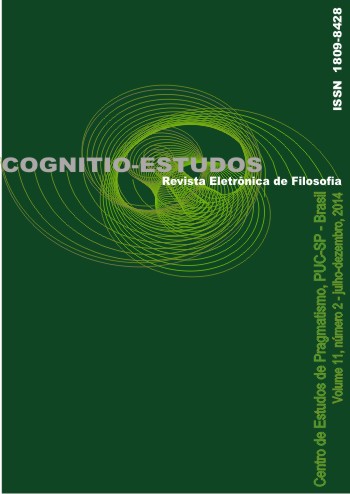Peirce’s “fundamental abduction”: how creativity entails cosmology
Palavras-chave:
Peirce – Abduction – Hope – Creativity – CosmologyResumo
The aim of the present paper is to explore the connection between Peirce’s theory of abduction and his cosmology, showing how his metaphysical and cosmological thoughts are required by his logical theory of abduction. To reach this goal, I first consider by and large the specific issue at stake – that is creativity – and then I briefly touch upon creativity’s implications to both Peirce’s “popular” theory of abduction, and his “unpopular” cosmology. Second, I tackle abduction and creativity with special reference to Peirce’s description of lume naturale and hope, and third I show how a critical account of abduction and creativity leads us toward cosmology and metaphysics. As a result, we will see how abduction and creativity involve a cosmology and need to be sustained by Synechism, in order to be fully comprehended and explained.
Métricas
Referências
ANDERSON, Douglas R. Creativity and the philosophy of C. S. Peirce. Dordrecht: Martinus Nijhoff, 1987.
_____. The evolution of the concept of abduction. In: Transactions of the Charles S. Peirce society, (vol. 22, 2, p. 145-164), 1986.
BARRENA, Sara. La razón creativa. Madrid: Ediciones Rialp, 2007.
BRADLEY, James. Transformations in speculative philosophy, 1870-1945. In: Cambridge history of philosophy. Edited by T. Baldwin. Cambridge: Cambridge University Press, 2003.
ECO, Umberto. Dall’albero al labirinto. studi storici sul segno e l’interpretazione. Milano: Bompiani, 2007.
FABBRICHESI, Rossella. Sulle tracce del segno. Semiotica, faneroscopia e cosmologia nel pensiero di Charles S. Peirce. Firenze: La Nuova Italia, 1986.
FANN, K. T. Peirce’s theory of abduction. The Hague: Martinus Nijhoff, 1970.
FISCH, Max H. Introductory note. In: SEBEOK, Th. A. The play of musement. Bloomington: Indiana University Press, 1981.
GOUDGE, Thomas. The thought of C.S. Peirce. Toronto: University of Toronto Press, 1950.
IBRI, Ivo Assad. The heuristic power of agapism in Peirce’s philosophy. In: Nóema, (ano 4, n. 2, p. 1-21), 2013.
MADDALENA, Giovanni; ZALAMEA, Fernando. Introduction. In: European journal of pragmatism and american jhilosophy, (v. 5, n.1, p. 6-8), 2013.
MADDALENA, Giovanni. Abduction and metaphysical realism. In: Semiotica, (v. 153, n.1/4, p. 243-259), 2005.
_____. Istinto razionale. studi sulla semiotica dell’ultimo Peirce. Torino: Trauben Editore, 2003.
MURPHEY, Murray G. The development of Peirce’s philosophy. Cambridge: Harvard University Press, 1961.
NUBIOLA, Jaime. Abduction or the logic of surprise. In: Semiotica, (v. 153, n.1/4, p. 117-130), 2005.
PEIRCE, Charles S. Collected papers of C.S. Peirce. Edited by C. Hartshorne, P. Weiss (vols. 1-6) and A. Burks (vols. 7-8). Cambridge: Harvard University Press, 1931-1958. [CP]
PEIRCE, Charles S. Reasoning and the logic of things. Cambridge: Harvard University Press 1992. [RLT]
PEIRCE, Charles S. The essential Peirce: selected philosophical writings. HOUSER; KLOESEL (eds.), 1992. (vol. 1); Peirce Edition Project ed., vol. 2. Bloomington: Indiana University, 1998. [EP]
PEIRCE, Charles S. Writings of Charles S. Peirce. Bloomington: Indiana University Press, 1982. [W]
SHORT, Thomas L. Did Peirce have a cosmology? In: Transactions of the Charles S. Peirce society (Vol. 46, n. 4, p. 521-543), 2010.
SINI, Carlo. Abduzione e cosmologia in Peirce. In: Aut aut, 1983. (v. 195-196, p. 13-20), 1983.
_____. Passare il segno: semiotica, cosmologia, tecnica. Milano: Il Saggiatore, 1981.
WHITEHEAD, Alfred N. Function of reason. Boston: Beacon Press, 1929.

